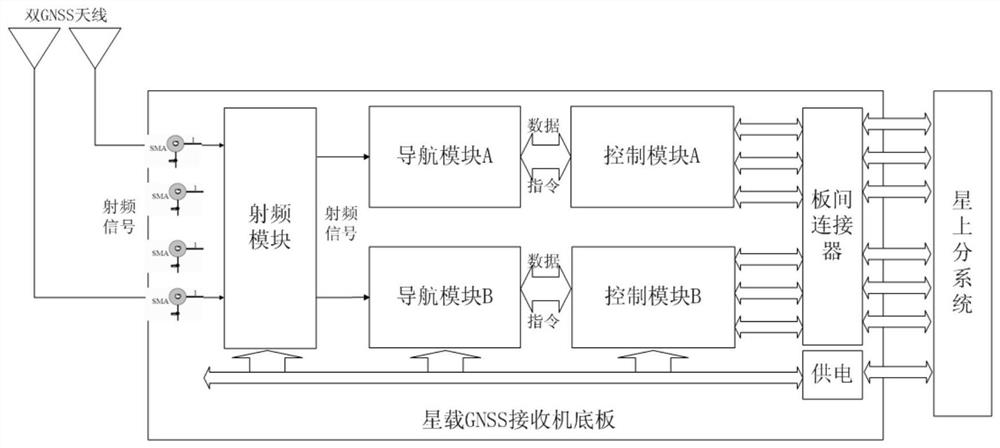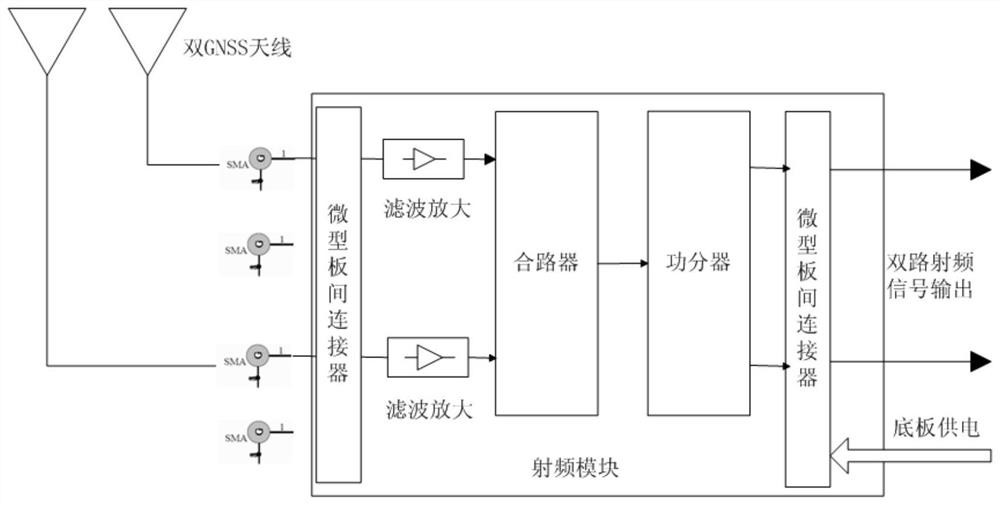Space-borne GNSS receiver based on reconfigurable modularization
A receiver and modular technology, applied in the field of satellite navigation, can solve the problems of space adaptability and reliability that cannot meet the needs of long-term on-orbit work, design, production costs and cycle compression, and cannot form mass production capacity. Achieve the effects of low power consumption, high functional density ratio, and high reliability
- Summary
- Abstract
- Description
- Claims
- Application Information
AI Technical Summary
Problems solved by technology
Method used
Image
Examples
Embodiment 1
[0030] The present invention provides a spaceborne GNSS receiver based on reconfigurable modularization, such as figure 1 As shown, it mainly includes radio frequency module, navigation module, control module and base plate. Navigation module A and navigation module B are the same type of navigation modules, they can be cold backup for each other, and they can also work at the same time. Control module A and control module B are the same type of control modules, they can be cold backup for each other, and they can also work at the same time.
[0031] The radio frequency module, navigation module and control module all adopt standardized structural design. The size of a single radio frequency module is 40×20mm, the size of a single navigation module is 40×40mm, and the size of a single control module is 40×40mm.
[0032] The backplane is used to provide inter-module interconnection, external interface, debugging interface and basic power supply; the radio frequency module, nav...
Embodiment 2
[0054] This example Figure 5 Shown:
[0055] (1) Choose 1 radio frequency module, 2 navigation modules, 2 control modules and the base board to realize the design of the spaceborne GNSS receiver.
[0056] (2) The radio frequency module supports three-way GNSS antenna input, and internally selects filters, low-noise amplifiers, three-in-one combiners, and one-to-two power dividers to output two-way radio frequency signals.
[0057] (3) Two navigation modules and two control modules are respectively selected, and the design in Embodiment 1 is followed, and dual-computer cold backup is adopted to improve space applicability and reliability.
[0058] (4) The radio frequency module, navigation module and control module all adopt standardized structure design and pin definition. The size of a single radio frequency module is 40×20mm, the size of a single navigation module is 40×40mm, and the size of a single control module is 40×40mm.
[0059] (5) The bottom board follows the des...
PUM
 Login to View More
Login to View More Abstract
Description
Claims
Application Information
 Login to View More
Login to View More - R&D
- Intellectual Property
- Life Sciences
- Materials
- Tech Scout
- Unparalleled Data Quality
- Higher Quality Content
- 60% Fewer Hallucinations
Browse by: Latest US Patents, China's latest patents, Technical Efficacy Thesaurus, Application Domain, Technology Topic, Popular Technical Reports.
© 2025 PatSnap. All rights reserved.Legal|Privacy policy|Modern Slavery Act Transparency Statement|Sitemap|About US| Contact US: help@patsnap.com



